半导体产业背景分析【英文】
- 格式:ppt
- 大小:141.50 KB
- 文档页数:23
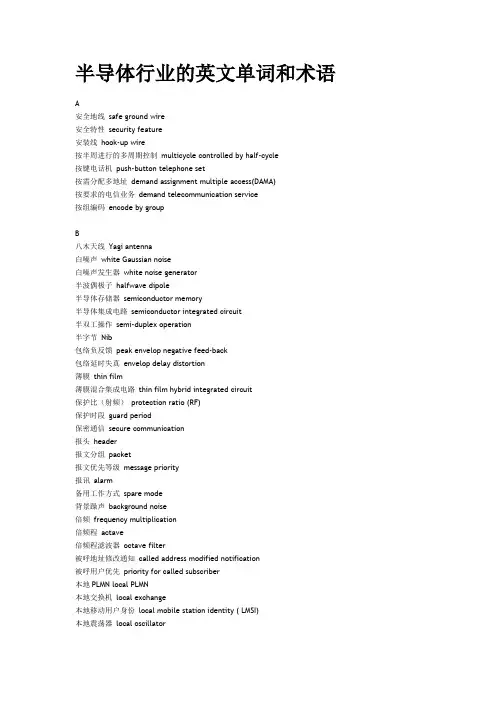
半导体行业的英文单词和术语A安全地线safe ground wire安全特性security feature安装线hook-up wire按半周进行的多周期控制multicycle controlled by half-cycle按键电话机push-button telephone set按需分配多地址demand assignment multiple access(DAMA)按要求的电信业务demand telecommunication service按组编码encode by groupB八木天线Yagi antenna白噪声white Gaussian noise白噪声发生器white noise generator半波偶极子halfwave dipole半导体存储器semiconductor memory半导体集成电路semiconductor integrated circuit半双工操作semi-duplex operation半字节Nib包络负反馈peak envelop negative feed-back包络延时失真envelop delay distortion薄膜thin film薄膜混合集成电路thin film hybrid integrated circuit保护比(射频)protection ratio (RF)保护时段guard period保密通信secure communication报头header报文分组packet报文优先等级message priority报讯alarm备用工作方式spare mode背景躁声background noise倍频frequency multiplication倍频程actave倍频程滤波器octave filter被呼地址修改通知called address modified notification被呼用户优先priority for called subscriber本地PLMN local PLMN本地交换机local exchange本地移动用户身份local mobile station identity ( LMSI)本地震荡器local oscillator比功率(功率密度) specific power比特bit比特并行bit parallel比特号码bit number (BN)比特流bit stream比特率bit rate比特误码率bit error rate比特序列独立性bit sequence independence必要带宽necessary bandwidth闭环电压增益closed loop voltage gain闭环控制closed loop control闭路电压closed circuit voltage边瓣抑制side lobe suppression边带sideband边带非线性串扰sideband non-linear crosstalk边带线性串扰sideband linear crosstalk边带抑制度sideband suppression边角辐射boundary radiation编号制度numbering plan编解码器codec编码encode编码律encoding law编码器encoder编码器输出encoder output编码器总工作时间encoder overall operate time编码效率coding efficiency编码信号coded signal编码约束长度encoding constraint length编码增益coding gain编译程序compiler鞭状天线whip antenna变频器converter变频损耗converter conversion loss变容二极管variable capacitance diode变形交替传号反转modified alternate mark inversion便携电台portable station便携设备portable equipment便携式载体设备portable vehicle equipment标称调整率(标称塞入率)nominal justification rate (nominal stuffing rate) 标称值nominal value标称呼通概率nominal calling probability标准码实验信号standard code test signal (SCTS)标准模拟天线standard artificial antenna标准频率standard frequency标准时间信号发射standard-time-signal emission标准实验调制standard test modulation标准输出功率standard power output标准输入信号standard input signal标准输入信号电平standard input-signal level标准输入信号频率standard input-signal frequency标准信躁比standard signal to noise表面安装surface mounting表示层presentation layer并串变换器parallel-serial converter (serializer)并馈垂直天线shunt-fed vertical antenna并行传输parallel transmission并行终端parallel terminal拨号错误概率dialing mistake probability拨号后延迟post-dialing delay拨号交换机dial exchange拨号线路dial-up line拨号音dialing tone拨号终端dial-up terminal波动强度(在给定方向上的)cymomotive force (c. m. f)波段覆盖wave coverage波峰焊wave soldering波特baud泊送过程Poisson process补充业务supplementary service (of GSM)补充业务登记supplementary service registration补充业务询问supplementary service interrogation补充业务互连supplementary service interworking捕捉区(一个地面接收台)capture area (of a terrestrial receiving station) 捕捉带pull-in range捕捉带宽pull-in banwidth捕捉时间pull-in time不连续发送discontinuous transmission (DTX)不连续干扰discontinuous interference不连续接收discontinuous reception (DRX)不确定度uncertainty步谈机portable mobile stationC采样定理sampling theorem采样频率sampling frequency采样周期sampling period参考边带功率reference side band power参考差错率reference error ratio参考当量reference equivalent参考点reference point参考结构reference configuration参考可用场强reference usable fiend-strength参考灵敏度reference sensibility参考频率reference frequency参考时钟reference clock参考输出功率reference output power残余边带调制vestigial sideband modulation残余边带发射vestigial-sideband emission操作维护中心operation maintenance center (OMC)操作系统operation system (OS)侧音消耗sidetone loss层2转发layer 2 relay (L2R)插入组装through hole pachnology插入损耗insertion loss查号台information desk差错控制编码error control coding差错漏检率residual error rate差分脉冲编码调制(差分脉码调制)differential pulse code modulation (DPCM) 差分四相相移键控differential quadrature phase keying (DQPSK)差分相移键控differential phase keying (DPSK)差模电压,平衡电压differential mode voltage, symmetrical voltage差拍干扰beat jamming差频失真difference frequency distortion长期抖动指示器long-term flicker indicator长期频率稳定度long-term frequency stability场强灵敏度field intensity sensibility场效应晶体管field effect transistor (FET)超长波通信myriametric wave communication超地平对流层传播transhorizon tropospheric超地平无线接力系统transhorizon radio-relay system超高帧hyperframe超帧superframe超大规模集成电路very-large scale integrated circuit (VLSI)超再生接收机super-regenerator receiver车载电台vehicle station撤消withdrawal成对不等性码(交替码、交变码)paired-disparity code (alternative code, alternating code)承载业务bearer service城市交通管制系统urban traffic control system程序设计技术programming technique程序设计环境programming environment程序优化program optimization程序指令program command充电charge充电率charge rate充电效率charge efficiency充电终止电压end-of charge voltage抽样sampling抽样率sample rate初级分布线路primary distribution link初始化initialization处理增益processing gain传播时延propagation delay传播系数propagation coefficient传导干扰conducted interference传导杂散发射conducted spurious emission传递函数transfer function传递时间transfer time传声器microphone传输保密transmission security传输层协议transport layer protocol传输集群transmission trunking传输结束字符end of transmission character传输媒体transmission medium传输损耗transmission loss传输损耗(无线线路的)transmission loss (of a radio link)传输通道transmission path传输信道transmission channel传真facsimile, FAX船舶地球站ship earth station船舶电台ship station船舶移动业务ship movement service船上通信电台on-board communication station ,ship communication station 船用收音机ship radio串并变换机serial to parallel (deserializer)串并行变换serial-parallel conversion串话crosstalk垂直方向性图vertical directivity pattern唇式传声器lip microphone磁屏蔽magnetic shielding次级分布线路secondary distribution link猝发差错burst error猝发点火控制burst firing control存储程序控制交换机stored program controlled switching systemD大规模集成电路large scale integrated circuit (LSI)大信号信躁比signal-to-noise ratio of strong signal带成功结果的常规操作normal operation with successful outcome 带宽bandwidth带内导频单边带pilot tone-in-band single sideband带内谐波in-band harmonic带内信令in-band signalling带内躁声in-band noise带通滤波器band-pass filter带外发射out-of-band emission带外功率out-of-band power带外衰减attenuation outside a channel带外信令out-band signalling带状线stripline单边带发射single sideband (SSB) emission单边带发射机single side-band (SSB) transmitter单边带调制single side band modulation单边带解调single side band demodulation单边带信号发生器single side band signal generaltor单端同步single-ended synchronization单工、双半工simplex, halfduplex单工操作simplex operation单工无线电话机simplex radio telephone单呼single call单频双工single frequency duplex单频信令single frequency signalling单相对称控制symmetrical control (single phase)单相非对称控制asymmetrical control (single phase)单向one-way单向的unidirectional单向控制unidirectional control单信道地面和机载无线电分系统SINCGARS单信道无绳电话机single channel cordless telephone单信号方法single-signal method单音tone单音脉冲tone pulse单音脉冲持续时间tone pulse duration单音脉冲的单音频率tone frequency of tone pulse单音脉冲上升时间tone pulse rise time单音脉冲下降时间tone pulse decay time单音制individual tone system单元电缆段(中继段)elementary cable section (repeater section) 单元再生段elementary regenerator section (regenerator section)单元增音段,单元中继段elementary repeater section当被呼移动用户不回答时的呼叫转移call forwarding on no reply (CFNRy)当被呼移动用户忙时的呼叫转calling forwarding on mobile subscriber busy (CFB)当漫游到原籍PLMN国家以外时禁止所有入呼barring of incoming calls when roaming outside the home PLMN country (BIC-Roam)当前服务的基站current serving BS当无线信道拥挤时的呼叫转移calling forward on mobile subscriber not reachable (CENRc)刀型天线blade antenna导频pilot frequency导频跌落pilot fall down倒L型天线inverted-L antenna等步的isochronous等幅电报continuous wave telegraph等权网(互同步网)democratic network (mutually synchronized network)等效比特率equivalent bit rate等效地球半径equivalent earth radius等效二进制数equivalent binary content等效全向辐射功率equivalent isotropically radiated power (e. i. r. p.)等效卫星线路躁声温度equivalent satellite link noise temperature低轨道卫星系统LEO satellite mobile communication system低气压实验low atmospheric pressure test低时延码激励线性预测编码low delay CELP (LD-CELP)低通滤波器low pass filter低温实验low temperature test低躁声放大器low noise amplifier地-空路径传播earth-space path propagation地-空通信设备ground/air communication equipment地波ground wave地面连线用户land line subscriber地面无线电通信terrestrial radio communication地面站(电台)terrestrial station第N次谐波比nth harmonic ratio第二代无绳电话系统cordless telephone system second generation (CT-2)第三代移动通信系统third generation mobile systems点波束天线spot beam antenna点对地区通信point-area communication点对点通信point-point communication点至点的GSM PLMN连接point to point GSM PLMN电报telegraphy电报电码telegraph code电波衰落radio wave fading电池功率power of battery电池能量energy capacity of battery电池容量battery capacity电池组battery电磁波electromagnetic wave电磁波反射reflection of electromagnetic wave电磁波饶射diffraction of electromagnetic wave电磁波散射scattering of electromagnetic wave电磁波色射dispersion of electromagnetic wave电磁波吸收absorption of electromagnetic wave电磁波折射refraction of electromagnetic wave电磁场electromagnetic field电磁发射electromagnetic field电磁辐射electromagnetic emission电磁干扰electromagnetic interference (EMI)电磁感应electromagnetic induction电磁环境electromagnetic environment电磁兼容性electromagnetic compatibility (EMC)电磁兼容性电平electromagnetic compatibility level 电磁兼容性余量electromagnetic compatibility margin 电磁脉冲electromagnetic pulse (EMP)电磁脉冲干扰electromagnetic pulse jamming电磁敏感度electromagnetic susceptibility电磁能electromagnetic energy电磁耦合electromagnetic coupling电磁屏蔽electromagnetic shielding电磁屏蔽装置electromagnetic screen电磁骚扰electromagnetic disturbance电磁噪声electromagnetic noise电磁污染electromagnetic pollution电动势electromotive force (e. m. f.)电话机telephone set电话局容量capacity of telephone exchange电话型电路telephone-type circuit电话型信道telephone-type channel电离层ionosphere电离层波ionosphere wave电离层传播ionosphere propagation电离层反射ionosphere reflection电离层反射传播ionosphere reflection propagation电离层散射传播ionosphere scatter propagation电离层折射ionosphere refraction电离层吸收ionosphere absorption电离层骚扰ionosphere disturbance电流探头current probe电屏蔽electric shielding电视电话video-telephone, viewphone, visual telephone电台磁方位magnetic bearing of station电台方位bearing of station电台航向heading of station电文编号message numbering电文队列message queue电文格式message format电文交换message switching电文交换网络message switching network电文结束代码end-of-message code电文路由选择message routing电小天线electronically small antenna电信管理网络telecommunication management network (TMN)电信会议teleconferencing电压变化voltage change电压变化持续时间duration of a voltage change电压变化的发生率rate of occurrence of voltage changes电压变化时间间隔voltage change interval电压波动voltage fluctuation电压波动波形voltage fluctuation waveform电压波动量magnitude of a voltage fluctuation电压不平衡voltage imbalance, voltage unbalance电压浪涌voltage surge电压骤降voltage dip电源power supply电源电压调整率line regulation电源抗扰性mains immunity电源持续工作能力continuous operation ability of the power supply 电源去耦系数mains decoupling factor电源骚扰mains disturbance电子干扰electronic jamming电子工业协会Electronic Industries Association (EIA)电子系统工程electronic system engineering电子自动调谐electronic automatic tuning电子组装electronic packaging电阻温度计resistance thermometer跌落试验fall down test顶部加载垂直天线top-loaded vertical antenna定长编码block code定期频率预报periodical frequency forecast定时clocking定时超前timing advance定时恢复(定时抽取)timing recovery (timing extration)定时截尾试验fixed time test定时信号timing signal定数截尾试验fixed failure number test定向天线directional antenna定型试验type test动态频率分配dynamic frequency allocation动态信道分配dynamic channel allocation动态重组dynamic regrouping动态自动增益控制特性dynamic AGC characteristic抖动jitter独立边带independent sideband独立故障independent fault端到端业务teleservice短波传播short wave propagation短波通信short wave communication短路保护short-circuit protection短期抖动指示器short-term flicker indicator短期频率稳定度short-term frequency stability短时间中断(供电电压)short interruption (of supply voltage)段终端section termination对称二元码symmetrical binary code对地静止卫星geostationary satellite对地静止卫星轨道geostationary satellite orbit对地同步卫星geosynchronous satellite对讲电话机intercommunicating telephone set对空台aeronautical station对流层troposphere对流层波道troposphere duct对流层传播troposphere propagation对流层散射传播troposphere scatter propagation多次调制multiple modulation多点接入multipoint access多电平正交调幅multi-level quadrature amplitude modulation (QAM) 多分转站网multidrop network多服务器队列multiserver queue多工multiplexing多工器nultiplexer多功能系统MRS多级处理multilevel processing多级互连网络multistage interconnecting network多级卫星线路multi-satellite link多径multipath多径传播multipath propagation多径传播函数nultipath propagation function多径分集multipath diversity多径时延multipath delay多径衰落multipath fading多径效应multipath effect多路复接multiplexing多路接入multiple access多路信道multiplexor channel多脉冲线性预测编码multi-pulse LPC (MPLC)多频信令multifrequency signalling多普勒频移Doppler shift多跳路径multihop path多信道选取multichannel access (MCA)多信道自动拨号移动通信系统multiple-channel mobile communication system with automatic dialing 多优先级multiple priority levels多帧multiframe多址呼叫multiaddress call多址联接multiple access多重时帧multiple timeframe多用户信道multi-user channelE额定带宽rated bandwidth额定射频输出功率rated radio frequency output power额定使用范围rated operating range额定音频输出功率rated audio-frequency output power额定值rated value爱尔兰erlang恶意呼叫识别malicious call identification (MCI)耳机(受话器)earphone耳机额定阻抗rated impedance of earphone二十进制码binary-coded decimal (BCD) code二十进制转换binary-to-decimal conversion二十六进制转换binary-to-hexadecimal conversion二进制码binary code二进制频移键控binary frequency shift keying (BFSK)二进制数binary figure二频制位binary digit(bit)二频制two-frequency system二维奇偶验码horizontal and vertical parity check code二线制two-wire system二相差分相移键控binary different phase shift keying (BDPSK)二相相移键控binary phase shift keying (BPSK)F发报机telegraph transmitter发射emisssion发射(或信号)带宽bandwidth of an emission (or a signal)发射机transmitter发射机边带频谱transmitter sideband spectrum发射机额定输出功率rated output power of transmitter发射机合路器transmitter combiner发射机冷却系统cooling system of transmitter发射机启动时间transmitter attack time发射机效率transmitter frequency发射机杂散躁声spurious transmitter noise发射机之间的互调iner-transmitter intermodulation发射机对答允许频(相)偏transmitter maximum permissible frequency(phase) deviation 发射类别class of emission发射频段transmit frequency band发射余量emission margin发送sending发送响度评定值send loudness rating (SLR)繁忙排队/自动回叫busy queuing/ callback反馈控制系统feedback control system反射功率reflection power反射卫星reflection satellite反向话音通道reverse voice channel (RVC)反向控制信道reverse control channel (RECC)泛欧数字无绳电话系统digital European cordless telephone方舱shelter方向性系数directivity of an antenna防爆电话机explosion-proof telephone set防潮moisture protection防腐蚀corrosion protection防霉mould proof仿真头artificial head仿真耳artificial ear仿真嘴artificial mouth仿真天线dummy antenna放大器amplifier放大器线性动态范围linear dynamic range of amplifier放电discharge放电电压discharge voltage放电深度depth of discharge放电率discharge rate放电特性曲线discharge character curve非等步的anisochronous非归零码nonreturn to zero code (NRZ)非均匀编码nonuniform encoding非均匀量化nonuniform quantizing非连续干扰discontinuous disturbance“非”门NOT gate非强占优先规则non-preemptive priority queuing discipline非受控滑动uncontrolled slip非线性电路nonlinear circuit非线性失真nonliear distortion非线性数字调制nonlinear digital modulation非占空呼叫建立off-air-call-set-up (OACSU)非专用控制信道non-dedicated control channel非阻塞互连网络non-blocking interconnection network分贝decibel (dB)分辨力resolution分布参数网络distributed parameter network分布式功能distributed function分布式数据库distributed database分别于是微波通信系统distributed microwave communication system 分布式移动通信系统distributed mobile communication system分布路线distribution link分段加载天线sectional loaded antenna分机extension分集diversity分集改善系数diversity improvement factor分集间隔diversity separation分集增益diversity gain分集接收diversity reception分接器demultiplexer分频frequency division分散定位distributed chann。

半导体方向英文普刊Semiconductor technology has been at the forefront of innovation and technological advancement for decades. As the world continues to rely heavily on electronic devices and digital technologies, the semiconductor industry has become increasingly crucial in shaping the future of various industries. One of the key aspects of this industry is the dissemination of knowledge and research through academic and industry publications.The semiconductor direction English publication serves as a vital platform for researchers, engineers, and industry professionals to share their findings, explore new frontiers, and stay informed about the latest developments in the field. These publications play a crucial role in driving the progress of semiconductor technology, fostering collaboration, and advancing the overall understanding of this complex and rapidly evolving field.One of the primary objectives of semiconductor direction English publications is to provide a comprehensive and up-to-date overview of the current state of the industry. These publications cover a widerange of topics, including materials science, device design, fabrication processes, circuit design, and system-level integration. By showcasing the latest research and innovations, these publications help to shape the direction of the semiconductor industry and inspire further advancements.Moreover, semiconductor direction English publications serve as a platform for the exchange of ideas and the dissemination of knowledge. Researchers and engineers from around the world contribute their research findings, case studies, and innovative solutions to these publications, allowing for the cross-pollination of ideas and the identification of emerging trends. This collaborative approach is essential in driving the semiconductor industry forward, as it enables the sharing of best practices, the identification of challenges, and the exploration of new avenues for exploration and development.One of the key strengths of semiconductor direction English publications is their ability to provide a global perspective on the industry. These publications often feature articles and research from diverse geographical regions, allowing readers to gain insights into the different approaches, challenges, and successes experienced in various parts of the world. This global outlook is particularly valuable in an industry that is inherently international, with supply chains, manufacturing facilities, and research centers spread across theglobe.In addition to disseminating research and technical knowledge, semiconductor direction English publications also play a crucial role in shaping the future of the industry. These publications often feature thought-leadership articles, industry analyses, and strategic insights that help to inform decision-makers, policymakers, and industry stakeholders. By providing a platform for the discussion of emerging trends, disruptive technologies, and long-term industry prospects, these publications contribute to the strategic planning and decision-making processes within the semiconductor industry.One of the key challenges facing the semiconductor direction English publication landscape is the rapid pace of technological change. The semiconductor industry is characterized by constant innovation, with new materials, device architectures, and manufacturing processes emerging at a breakneck pace. Keeping up with these advancements and ensuring the timely dissemination of relevant and accurate information is a significant challenge for these publications.To address this challenge, semiconductor direction English publications have had to adapt and evolve their editorial and publishing strategies. This has often involved the adoption of digital platforms, the use of data analytics to identify emerging trends, and the development of specialized content streams to cater to thediverse needs of their readership. Additionally, these publications have had to maintain a strong focus on quality, accuracy, and relevance, ensuring that the information they provide is both cutting-edge and reliable.Another challenge facing semiconductor direction English publications is the need to balance the technical depth and rigor required by the industry with the need to communicate complex concepts in an accessible and engaging manner. Semiconductor technology is inherently complex, with a high degree of technical jargon and specialized knowledge. Translating this technical information into a format that is understandable and relevant to a broad audience of industry professionals, researchers, and policymakers is a significant challenge that these publications must navigate.To address this challenge, semiconductor direction English publications have had to develop innovative editorial strategies, such as the use of visual aids, case studies, and industry-specific language guides. They have also had to cultivate a pool of highly skilled writers and editors who are capable of translating complex technical concepts into clear and compelling narratives.Despite these challenges, semiconductor direction English publications continue to play a vital role in the advancement of thesemiconductor industry. By providing a platform for the dissemination of knowledge, the exchange of ideas, and the exploration of emerging trends, these publications have become essential resources for industry professionals, researchers, and policymakers alike.Looking to the future, it is clear that the importance of semiconductor direction English publications will only continue to grow. As the semiconductor industry continues to evolve and shape the technological landscape, the need for high-quality, authoritative, and forward-looking publications will become increasingly critical. These publications will be called upon to not only report on the latest developments, but also to provide strategic insights, thought leadership, and a global perspective on the industry's trajectory.In conclusion, semiconductor direction English publications are essential components of the semiconductor industry, serving as vital platforms for the dissemination of knowledge, the exchange of ideas, and the exploration of emerging trends. Despite the challenges posed by the rapid pace of technological change and the need to balance technical depth with accessibility, these publications continue to play a crucial role in driving the progress of the semiconductor industry and shaping its future direction. As the world becomes increasingly reliant on electronic devices and digital technologies, the importance of these publications will only continueto grow, making them indispensable resources for industry professionals, researchers, and policymakers alike.。
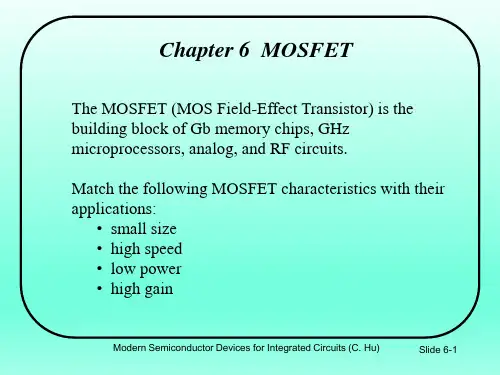
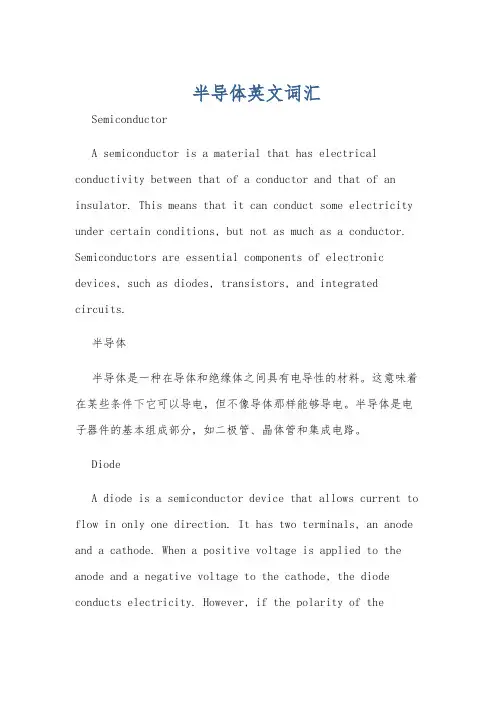
半导体英文词汇SemiconductorA semiconductor is a material that has electrical conductivity between that of a conductor and that of an insulator. This means that it can conduct some electricity under certain conditions, but not as much as a conductor. Semiconductors are essential components of electronic devices, such as diodes, transistors, and integrated circuits.半导体半导体是一种在导体和绝缘体之间具有电导性的材料。
这意味着在某些条件下它可以导电,但不像导体那样能够导电。
半导体是电子器件的基本组成部分,如二极管、晶体管和集成电路。
DiodeA diode is a semiconductor device that allows current to flow in only one direction. It has two terminals, an anode and a cathode. When a positive voltage is applied to the anode and a negative voltage to the cathode, the diode conducts electricity. However, if the polarity of theapplied voltage is reversed, the diode blocks the flow of current.二极管二极管是一种只允许电流在一个方向中流动的半导体器件。
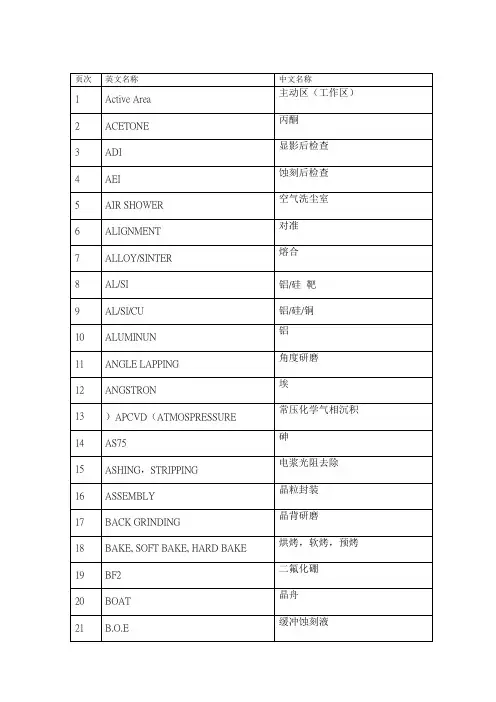
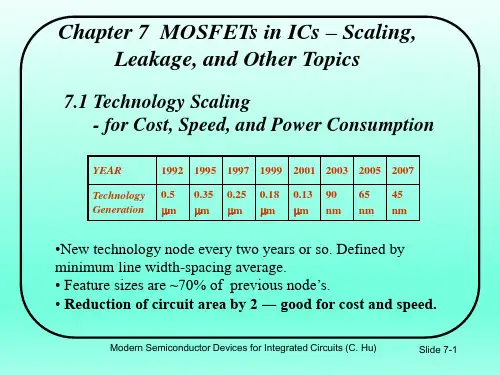
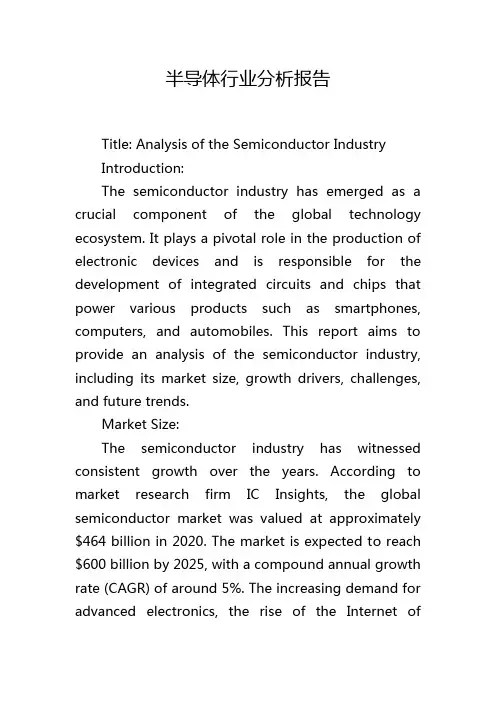
半导体行业分析报告Title: Analysis of the Semiconductor IndustryIntroduction:The semiconductor industry has emerged as a crucial component of the global technology ecosystem. It plays a pivotal role in the production of electronic devices and is responsible for the development of integrated circuits and chips that power various products such as smartphones, computers, and automobiles. This report aims to provide an analysis of the semiconductor industry, including its market size, growth drivers, challenges, and future trends.Market Size:The semiconductor industry has witnessed consistent growth over the years. According to market research firm IC Insights, the global semiconductor market was valued at approximately $464 billion in 2020. The market is expected to reach $600 billion by 2025, with a compound annual growth rate (CAGR) of around 5%. The increasing demand for advanced electronics, the rise of the Internet ofThings, and the proliferation of artificial intelligence are some of the key factors driving the growth of the semiconductor market.Growth Drivers:1. Increasing Demand for Electronics: The growing adoption of electronics in various sectors such as healthcare, automotive, and telecommunications is fueling the demand for semiconductors. The expansion of consumer electronics, including smartphones, tablets, and smart home devices, is also contributing to the industry's growth.2. Internet of Things (IoT): The IoT revolution is significantly impacting the semiconductor industry. With the increasing number of connected devices and the need for efficient data processing and storage, semiconductors play a critical role in enabling IoT applications. The widespread deployment of IoT devices in industries such as manufacturing, transportation, and healthcare is expected to drive the demand for semiconductors.3. Artificial Intelligence (AI): AI has become a transformative technology in various fields, including autonomous vehicles, robotics, and imagerecognition. These applications require high-performance processors and chips, which are produced by the semiconductor industry. The continued advancement of AI technology is expected to fuel the growth of the semiconductor market.Challenges:1. Supply Chain Disruptions: The semiconductor industry faces challenges related to the global supply chain. The COVID-19 pandemic highlighted the vulnerabilities in the supply chain, disrupting production and causing shortages of critical components. Geopolitical tensions and trade conflicts can also impact the supply of raw materials and components, affecting the overall industry.2. Technological Complexity: As technology becomes more advanced, the complexity of semiconductor design and manufacturing increases. Developing and manufacturing smaller, faster, and more efficient chips require significant investments in research and development. The industry must constantly innovate to stay competitive, which adds additional challenges.Future Trends:1. 5G Technology: The rollout of 5G networks will create opportunities for the semiconductor industry. With faster connectivity and increased data transfer rates, 5G will require the development of advanced chips capable of handling the increased demand for data processing and storage.2. Electric Vehicles (EVs): The global shift towards electric vehicles presents a significant growth opportunity for the semiconductor industry. EVs rely on semiconductors for various applications, including battery management, power electronics, and advanced driver-assistance systems (ADAS).3. Artificial Intelligence and Machine Learning: The integration of AI and machine learning technologies into various industries will drive the demand for high-performance processors and chips. The semiconductor industry is expected to continue innovating to support the evolving needs of AI applications.Conclusion:The semiconductor industry is poised for continued growth due to the increasing demand for advanced electronics, the rise of IoT and AI technologies, and future trends such as 5G andelectric vehicles. However, challenges related to the global supply chain and technological complexity must be addressed. As the industry evolves, innovative solutions and collaborations will be crucial for the sustained success of semiconductor companies.。

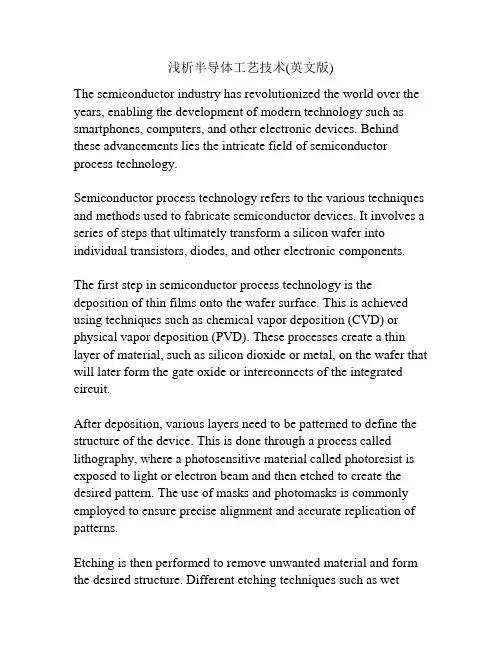
浅析半导体工艺技术(英文版)The semiconductor industry has revolutionized the world over the years, enabling the development of modern technology such as smartphones, computers, and other electronic devices. Behind these advancements lies the intricate field of semiconductor process technology.Semiconductor process technology refers to the various techniques and methods used to fabricate semiconductor devices. It involves a series of steps that ultimately transform a silicon wafer into individual transistors, diodes, and other electronic components.The first step in semiconductor process technology is the deposition of thin films onto the wafer surface. This is achieved using techniques such as chemical vapor deposition (CVD) or physical vapor deposition (PVD). These processes create a thin layer of material, such as silicon dioxide or metal, on the wafer that will later form the gate oxide or interconnects of the integrated circuit.After deposition, various layers need to be patterned to define the structure of the device. This is done through a process called lithography, where a photosensitive material called photoresist is exposed to light or electron beam and then etched to create the desired pattern. The use of masks and photomasks is commonly employed to ensure precise alignment and accurate replication of patterns.Etching is then performed to remove unwanted material and form the desired structure. Different etching techniques such as wetetching, dry etching, and plasma etching are used depending on the material being etched and the desired result.To create the necessary electrical connections between different layers or components, a technique called metallization is employed. This involves depositing metal layers, typically aluminum or copper, onto the wafer surface, which are then patterned and etched to form the desired interconnects.Throughout the entire process, various quality control steps are implemented to ensure the reliability and functionality of the fabricated devices. These include testing for defects, measuring electrical parameters, and assessing the overall performance of the components.The constant advancement in semiconductor process technology has led to the miniaturization of devices, with transistors becoming smaller and more efficient with each generation. This has been made possible by improving techniques such as photolithography, which now allows for the creation of features as small as a few nanometers.In conclusion, semiconductor process technology is a critical aspect of the semiconductor industry, enabling the fabrication of complex integrated circuits that power our modern world. The techniques and methods involved in this field continue to evolve, allowing for the development of smaller, faster, and more energy-efficient semiconductor devices.Semiconductor process technology has played a crucial role in driving technological advancements and shaping various industries. In this section, we will exploresome specific aspects of semiconductor process technology and its impact.One of the significant developments in semiconductor process technology is the transition from larger feature sizes to smaller feature sizes. This is commonly referred to as the shrinking of process technology nodes. The International Technology Roadmap for Semiconductors (ITRS) has been instrumental in setting goals and guiding the industry in achieving these advancements. The constant reduction in feature sizes has led to an increase in the number of transistors that can be packed onto a single chip, resulting in more powerful and capable devices.As the feature sizes decrease, new challenges arise due to physical limitations and the behavior of materials at such small scales. One such challenge is the control of leakage current. As feature sizes shrink, the distance between components on a chip reduces, leading to increased current leakage. Semiconductor manufacturers have employed various techniques, such as high-k dielectrics, to counteract this effect and maintain low leakage levels.Another notable development in semiconductor process technology is the implementation of new materials and structures to enhance performance. For instance, the introduction of strained silicon has allowed for higher electron mobility, resulting in faster and more efficient transistors. Additionally, the use of FinFET (Fin Field-Effect Transistor) structures has enabled better control of electrical current flow, leading to lower power consumption and improved performance.Besides feature size reductions, semiconductor process technology has also focused on enhancing device functionality and integration. This has led to the incorporation of new manufacturing techniques, such as three-dimensional (3D) integration. 3D integration allows for stacking multiple layers of devices, optimizing space utilization and enabling the integration of diverse functionalities on a single chip. It facilitates the development of advanced packaging solutions, such as System-on-Chip (SoC) and System-in-Package (SiP), which offer higher performance and more compact form factors.Semiconductor process technology has also played a crucial role in enabling the development of specialty devices, such as microelectromechanical systems (MEMS) and sensors. MEMS devices incorporate mechanical structures and electronics on a single chip, enabling the fabrication of sensors, actuators, and other microscale mechanical components. Semiconductor process technology has enabled the precise fabrication of these structures, allowing for widespread adoption in applications such as automotive, healthcare, and consumer electronics.The advancements in semiconductor process technology have significantly impacted numerous industries. For example, the smartphone industry has greatly benefited from the miniaturization and improved performance of semiconductor devices. Smaller and more energy-efficient transistors have enabled the development of powerful processors and memory, leading to faster and more capable smartphones. Additionally, advancements in semiconductor process technology have enabled the integration of various sensors, such as accelerometers and gyroscopes,facilitating features like motion sensing and augmented reality.The automotive industry has also witnessed significant advancements due to semiconductor process technology. The increasing integration of semiconductor devices in vehicles has enabled the development of advanced safety features, smart infotainment systems, and electric powertrain solutions. Semiconductor process technology has enabled the manufacture of more robust and reliable chips that can withstand harsh operating conditions in automotive applications.Moreover, the field of healthcare has been revolutionized by semiconductor process technology. The development of wearable devices, medical imaging systems, and diagnostic tools has been made possible by the miniaturization and improved functionality of semiconductor devices. These advancements have facilitated more accurate diagnoses, continuous monitoring of vital signs, and efficient delivery of healthcare services.In conclusion, semiconductor process technology has been instrumental in shaping the modern world through its continuous advancements. The ability to fabricate smaller, more efficient, and higher-performing semiconductor devices has revolutionized various industries. As technology continues to evolve and new challenges emerge, semiconductor process technology will remain crucial in addressing these challenges and driving further innovation.。


The semiconductor industry, often referred to as the backbone of modern technology, has seen exponential growth over the past few decades. It is a crucial component in various electronic devices, including smartphones, computers, medical equipment, and automotive systems. This summary aims to provide an overview of the key aspects of the semiconductor industry, its evolution, current state, and future prospects.Evolution of the Semiconductor IndustryThe history of the semiconductor industry dates back to the late 1940s when the first semiconductor device, the Point Contact Transistor, was invented. However, it was the invention of the Junction Transistor by William Shockley in 1947 that marked the beginning of the modern semiconductor era. Over the years, advancements in semiconductor technology have led to the miniaturization of devices, improved performance, and reduced costs.The development of integrated circuits (ICs) in the late 1950s and early 1960s revolutionized the industry. These circuits, which integrated thousands of transistors onto a single chip, paved the way for thedigital revolution. The advancements continued with the transition from small-scale integration (SSI) to medium-scale integration (MSI), large-scale integration (LSI), and eventually to very large-scale integration (VLSI) and ultra-large-scale integration (ULSI).Current State of the Semiconductor IndustryToday, the semiconductor industry is a multi-billion-dollar global market. It is characterized by fierce competition, rapid technological innovation, and high capital investment. The industry is segmented into various categories, including microprocessors, memory devices, analog devices, and discrete semiconductors.1. Microprocessors: These are the central processing units (CPUs) that power computers and other electronic devices. Companies like Intel, AMD, and ARM dominate this segment.2. Memory Devices: This category includes Dynamic Random-Access Memory (DRAM) and Static Random-Access Memory (SRAM), which are essential forstoring data. Samsung, SK Hynix, and Micron are key players in this segment.3. Analog Devices: These devices handle analog signals and are used in various applications, such as power management, signal conditioning, and audio processing. Texas Instruments, Analog Devices, and ON Semiconductor are leading companies in this area.4. Discrete Semiconductors: These are individual semiconductor devices, such as diodes, transistors, and thyristors, which are used in a wide range of applications. Infineon, ON Semiconductor, and NXP Semiconductors are prominent in this segment.Challenges and OpportunitiesThe semiconductor industry faces several challenges, including supply chain disruptions, geopolitical tensions, and increasing demand for advanced technologies. However, these challenges also present opportunities for innovation and growth.1. Supply Chain Disruptions: The COVID-19 pandemic highlighted the vulnerabilities of global supply chains. To mitigate this risk, companies are looking to diversify their supply chains and invest in local production facilities.2. Geopolitical Tensions: Trade wars and geopolitical tensions have created uncertainties in the semiconductor industry. Companies are navigating these challenges by establishing strategic partnerships and diversifying their operations.3. Advanced Technologies: The industry is increasingly focusing on advanced technologies such as 5G, artificial intelligence (AI), and the Internet of Things (IoT). These technologies are expected to drive demand for semiconductors and create new markets.Future ProspectsThe future of the semiconductor industry looks promising, with continuous advancements in technology and increasing demand for electronic devices. Key trends include:1. 5G Technology: The rollout of 5G networks will require more advanced and efficient semiconductors to support the high data throughput and low latency requirements.2. AI and IoT: The integration of AI and IoT into various devices will drive the need for more powerful and energy-efficient semiconductors.3. Green Technology: As the world moves towards sustainability, the semiconductor industry is focusing on developing energy-efficient devices and recycling processes.In conclusion, the semiconductor industry has come a long way since its inception and continues to evolve at a rapid pace. With ongoing technological advancements and increasing demand, the industry is poised for continued growth and innovation in the coming years.。
英语作文-集成电路设计行业的国内外市场对比与竞争态势In the realm of Integrated Circuit (IC) Design, a captivating comparison and analysis of the domestic and international markets reveals a dynamic landscape shaped by technological advancements, competitive dynamics, and global trends. This discourse delves into the intricate dynamics that define the industry's landscape.IC Design, at its core, is a pivotal player in the digital age, driving innovation across various sectors. The global market, with its massive scale and rapid growth, is dominated by giants like Intel, TSMC, and Samsung, who hold sway in both the semiconductor manufacturing and design sectors. These companies, with their deep technological know-how and economies of scale, set the benchmark for international competition.On the domestic front, countries like the United States, China, and Taiwan have emerged as significant players. The US, with its strong tradition in research and development, houses numerous leading IC design firms. China, on the other hand, has seen a rapid rise in its IC industry, driven by government initiatives and the growing demand for local manufacturing. Taiwan, known for its expertise in analog and memory chips, remains a key player in the Asian market.The competition in this industry is intense, driven by innovation, cost efficiency, and regulatory environments. Innovation is the lifeblood, with constant advancements in technology pushing companies to outdo each other. The race for smaller, faster, and more power-efficient chips is a key battlefield. Companies must navigate the balance between investing in R&D and maintaining profitability.International trade dynamics play a crucial role. Tariffs, trade agreements, and geopolitical tensions can significantly impact the supply chain, affecting both the competitiveness and stability of the market. The ongoing shift towards global supply chains, however, also presents opportunities for smaller, niche players to find their niche.The competition is not just within the industry, but also with emerging technologies like 5G, AI, and the Internet of Things (IoT). These sectors are driving a surge in IC demand, creating a fertile ground for growth and innovation. Companies must adapt to these changes to stay relevant.In conclusion, the IC Design industry, with its global and domestic markets, is a dynamic and competitive arena. The future is shaped by the relentless pursuit of innovation, the evolving regulatory landscape, and the relentless drive for technological superiority. As the industry continues to evolve, it promises to be a fascinating journey, where both established players and new entrants vie for dominance in the digital age.。